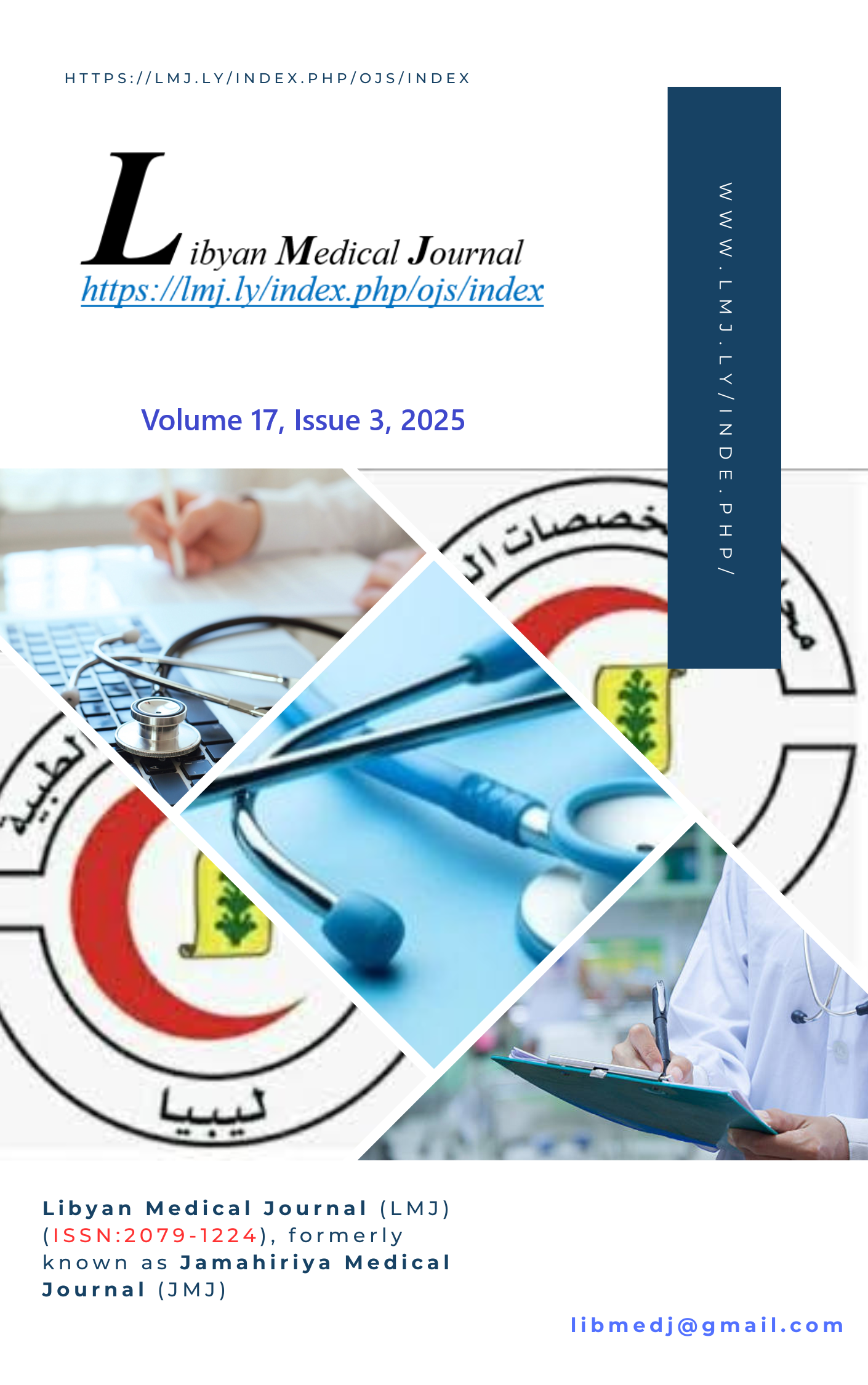Prevalence and Risk Patterns of Metabolic Syndrome Among Patients with Ischemic Heart Disease in Tripoli, Libya
DOI:
https://doi.org/10.69667/lmj.2517323Abstract
Metabolic syndrome (MetS) represents a constellation of cardiometabolic abnormalities that considerably raise the risk of cardiovascular disease and type 2 diabetes. This hospital-based prospective study investigated the frequency, demographic distribution, and determinants of MetS among ischemic heart disease (IHD) patients in Tripoli, Libya. A total of 227 adults were assessed, including 127 individuals with established IHD and 100 without IHD. MetS was identified using the International Diabetes Federation (IDF, 2005) and the revised National Cholesterol Education Program Adult Treatment Panel III (NCEP ATP III, 2005) definitions. Data collection included anthropometric indices, blood pressure, fasting glucose, lipid profile, lifestyle practices, and family history through structured interviews. The occurrence of MetS was significantly higher in the IHD group: 68.5% (IDF) and 65.4% (NCEP ATP III), compared to 41% and 39% among controls (P<0.001). Abdominal obesity and hypertension were the most common abnormalities, followed by reduced HDL-C and raised fasting glucose. Prevalence increased with age, and clustering was more evident in women in the control group. Multivariable analysis revealed obesity (BMI ≥30 kg/m²), physical inactivity, high-fat diet, and family history of hypertension or diabetes as independent predictors (P<0.05). These results demonstrate a substantial burden of MetS among IHD patients in Libya, emphasizing the importance of early risk detection, lifestyle modification, and integrated management to mitigate cardiovascular complications.
References
Kylin E. Studien ueber das Hypertonie-Hyperglykämie-Hyperurikämiesyndrom. Zentralbl Innere Med. 1923;44:105-27.
Reaven GM. Role of insulin resistance in human disease. Diabetes. 1988;37:1595-607.
World Health Organization. Definition, diagnosis and classification of diabetes mellitus and its complications. Geneva: WHO; 1999.
National Cholesterol Education Program (NCEP) Expert Panel. Third report of the National Cholesterol Education Program (NCEP) expert panel on detection, evaluation, and treatment of high blood cholesterol in adults (Adult Treatment Panel III). Circulation. 2001;106:3143-421.
Grundy SM, Cleeman JI, Daniels SR, et al. Diagnosis and management of the metabolic syndrome: an American Heart Association/NHLBI scientific statement. Circulation. 2005;112:2735-52.
Alberti KG, Zimmet P, Shaw J. Metabolic syndrome—a new worldwide definition. Lancet. 2005;366:1059-62.
Alberti KG, Eckel RH, Grundy SM, et al. Harmonizing the metabolic syndrome: a joint interim statement. Circulation. 2009;120:1640-5.
Eckel RH, Grundy SM, Zimmet PZ. The metabolic syndrome. Lancet. 2005;365:1415-28.
Saklayen MG. The global epidemic of the metabolic syndrome. Curr Hypertens Rep. 2018;20:12.
Grundy SM. Metabolic syndrome update. Circulation. 2021;103:101-12.
International Diabetes Federation. IDF diabetes atlas. 10th ed. Brussels: IDF; 2022.
NCD Risk Factor Collaboration. Worldwide trends in body-mass index. Lancet. 2016;387:1377-96.
NCD Risk Factor Collaboration. Worldwide trends in diabetes. Lancet. 2017;390:2461-75.
Yusuf S, Hawken S, Ounpuu S, et al. Effect of potentially modifiable risk factors associated with myocardial infarction in 52 countries (the INTERHEART study). Lancet. 2004;364:937-52.
Emerging Risk Factors Collaboration. Major vascular risk factors. Lancet. 2019;381:112-23.
Saeedi P, Petersohn I, Salpea P, et al. Global and regional diabetes prevalence estimates. Diabetes Res Clin Pract. 2019;157:107843.
American Heart Association. Heart disease and stroke statistics—2023 update. Circulation. 2023;147:e93-621.
World Health Organization. Cardiovascular diseases (CVDs): fact sheet. Geneva: WHO; 2023.
Ford ES, Li C, Zhao G. Prevalence and correlates of metabolic syndrome among US adults. J Diabetes. 2010;2:180-93.
Cameron AJ, Shaw JE, Zimmet PZ. The metabolic syndrome: prevalence in worldwide populations. Diabetes Care. 2004;27:607-11.
Hildrum B, Mykletun A, Hole T, et al. Prevalence of the metabolic syndrome and its components in an adult Norwegian population. BMC Public Health. 2007;7:220.
Mente A, de Koning L, Shannon HS, Anand SS. A systematic review of the evidence supporting a causal link between dietary factors and coronary heart disease. BMJ. 2009;338:b1329.
Al-Daghri NM, Al-Attas OS, Alokail MS, et al. Prevalence of metabolic syndrome in Saudi adults. Metab Syndr Relat Disord. 2010;9:19-25.
Alhyas L, McKay A, Majeed A. Prevalence of metabolic syndrome in the Gulf countries: a systematic review. Diabetes Res Clin Pract. 2012;96:214-22.
Elhadd TA, Al-Amiri E, Al-Shaikh M, et al. Metabolic syndrome in United Arab Emirates adults: prevalence and risk factors. Diabetes Res Clin Pract. 2016;120:69-75.
Khalil S, Al-Tamimi M, Al-Mutairi S. Metabolic syndrome in Middle East and North Africa (MENA) countries. Int J Cardiol. 2021;329:107-14.
Eltayeb W, Ben Amer K, Al-Mugadmi S. Metabolic syndrome prevalence among Libyan type 2 diabetes mellitus patients. Libyan J Med. 2019;14:156.
Ben Hamed K, Elmahdi M, Alhassan M. Metabolic syndrome prevalence among Libyan adults. Univ Tripoli Med J. 2020;12:15-24.
Musaiger AO. Overweight and obesity in the Eastern Mediterranean Region: prevalence and possible causes. East Mediterr Health J. 2011;17:100-8.
Alhyas L, McKay A, Majeed A. Lifestyle factors and metabolic syndrome in Middle Eastern populations. Diabetes Res Clin Pract. 2012;96:89-95.











